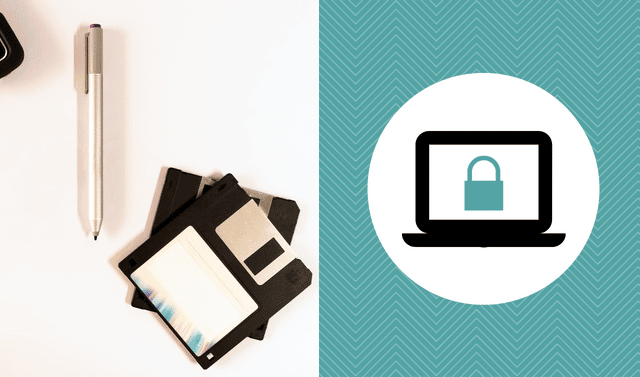
“Get your head out of the clouds” was once a common directive from grade-school teachers who wanted kids to stop daydreaming and pay attention to long division. Nowadays, we’re learning that it’s not so bad to be in the clouds—well, actually, the cloud. Today’s cloud is an off-site, online way to store your genealogy and other data.
In the cloud, you have 24/7 access to your information from any internet-connected device: a desktop computer (at home, work or the library), laptop, tablet or smartphone. Your files are automatically backed up online and, as long as you take security precautions, protected. If you’re tired of keeping your research on various CDs, DVDs, flash drives and hard drives, you owe it to yourself to learn more about cloud computing. Despite what your teacher told you, maybe it’s time to get your head (and your genealogy files )into the cloud. Here’s why—and how.
What exactly is the “cloud”?
There’s actually some history behind the use of the word cloud to describe the way a computer user accesses data stored somewhere other than his own computer. Years ago, when computer systems were mapped out using a flow chart, a cloud was the symbol for a remote server that hosted data and services. For the most part, this server was provided by another business or vendor and located off-site.
In the 21st-century digital age of high-speed internet, we envision an imaginary space hovering over us, like a cloud, filled with data. Using the cloud isn’t complicated. In fact, many genealogists are already using some type of cloud computing without even realizing it.
Here’s a simple way to look at it: Say you normally keep GEDCOM files, digitized photos and documents, and other files on your own hard drive. Suppose you were to upload the data onto a family tree website provided by a company such as Ancestry.com or a file storage site such as Dropbox. Then you’d turn on another device, such as your laptop or tablet, and access your data from there. You’re in the cloud.
You can use the cloud for more than just storing data. Instead of desktop software, many genealogists use cloud-based services—tree-building websites, spreadsheet apps and note-taking sites—to track their family trees. These researchers are actually working in the cloud, not merely putting files there.
So in reality, cloud computing is just a change in the way you work with your data. It’s a conscious decision to store and perhaps work with your data off-site so you can do more with it.
Why should I use the cloud?
If your research process is working for you, why change it to use the cloud? Taking advantage of the cloud can improve your genealogical efficiency and offer safeguards. Consider these benefits:
File backups
Especially with cloud services that incorporate automatic file syncing (rather than requiring you to manually back up files), you don’t need to worry about losing data due to hard drive failures or a stolen laptop.
Anywhere access
As long as you have an internet connection and a computing device, you’ll have access to your genealogy data in the cloud. That’s super convenient for research trips, family gatherings or anytime you need to find a bit of family data and you’re not near your paper files or home computer.
Multiple access points
No more copying data with a flash drive to multiple computers. Change a file in one location, and the change gets updated on all devices, including mobile phones. Look for programs such as Dropbox or Evernote that allow you to synchronize, or “sync,” data across multiple devices.
Research sharing
One of the hallmarks of the genealogy community is its willingness to share research. Cloud computing lets you take that sharing to a new level. With some services, such as Ancestry.com’s family trees, you can let select others or the public at large search and view your family tree data. Other services require you to invite others to access your data. Dropbox, for example, allows you to invite others to a folder where they can edit or delete files; you get 30 days to review how they’ve used your data. Its competitor SugarSync allows you to set permissions on individual files and folders.
The best way to get the most out of sharing genealogy information and images in the cloud is to know who’s using your research and explain to them what they should or shouldn’t be doing with it.
How do I use the cloud?
If you have a Google account, or you’ve put your family tree on a website such as Ancestry.com, you’ve already used the cloud. But you probably could be using it in many more ways by taking advantage of other types of cloud services, such as:
Family tree services
Family tree building sites include genealogy records sites such as Ancestry.com, as well as dedicated pedigree services such as WikiTree and Geni. Many researchers use these sites, which you usually can search to find the same folks in others’ trees, in conjunction with traditional genealogy software. Most sites let you create your tree for free, though some have limitations on your tree size or the amount of data you can store. They also generally don’t have an automatic synchronization method letting you keep a local copy; your best option is to occasionally export your data to a GEDCOM file or other file format.
Genealogy software
A few services act as traditional genealogy software, except they’re online instead of on your computer. This makes it easier to collaborate with distant relatives on research projects. You’ll generally pay a monthly or annual usage fee.
Many desktop genealogy programs are getting into the cloud act by providing synchronization features that let you easily upload your data to cloud storage on the software company’s website. You also may be able to download an app that lets you access your stored data using a tablet or smartphone. If you already have a favorite genealogy program, look into the cloud-computing options it provides.
File-hosting services
Though these services aren’t generally designed specifically for genealogy research, family historians find them useful for backing up family tree files and digitized records. You can find file-hosting services for just about any type of file for GEDCOMs and genealogy programs’ native file formats. Some sites, such as Flickr, are designed just for photo storage (these services also make it easy to share photos online). Many file-hosting sites offer a small amount of free storage and a range of premium packages with more storage space for a monthly or annual fee.
Find out whether the cloud sites you’re considering automatically back up your files or whether you must perform manual backups, and look for apps that let you access the files on a mobile device.
Note-taking and research services
A host of sites and apps act as “virtual assistants” that help you organize your research. These programs, which include Evernote and Microsoft OneNote, aren’t easy to describe: Use them to take notes, capture websites, create lists, share and store files, and more. Most will store your genealogy “finds” online so you can access them on your computer and, with an app, your mobile device. They generally start free, with paid premium services.
Document creation
Most genealogy researchers still use desktop software to create documents and spreadsheets, but programs are available in the cloud that allow you to write family histories or collect data in a research log spreadsheet. Google Drive offers this ability, for example, and even Microsoft Office has a cloud option available in its Microsoft Office 365. These services let you create and store your documents in the cloud, and the software will always be up to date—no upgrades required.
How do I choose my cloud services?
First, decide how you’d like to use the cloud. For example, maybe you want to back up your GEDCOM files, digitized documents and research notes, and keep an online family tree that syncs with your desktop genealogy software. You’ll need to choose a file backup service and a family tree website that works with your software. If you also want to access your tree using your smartphone or tablet, you’ll want a family tree site that has a mobile app, too.
Or maybe you want to create, edit and store documents, such as your genealogy research log or family history narratives, in the cloud (as opposed to on your computer). Choose a document creation app—perhaps one with built-in online file storage. In this case, you’ll want to regularly export your files to your computer so you’ll have backups.
Next, you’ll need to consider which sites and apps work with cloud services you may already use and the computing devices you own. If you use Gmail, for example, and have an Android phone, it might be easiest to create and back up files on Google Drive and store photos on Google Photos. Got a Windows Live account? Try OneDrive for data storage and Microsoft OneNote for note taking. If you’re an iPhone and iPad fan, consider using Apple’s iCloud program for your data storage and syncing. It’s built into every new iOS device and every new Mac.
When choosing which cloud services to use, it pays to research your options, focusing first on your must-have features and second on the nice-to-have ones. Visit each service’s website, check out online reviews (search for the name of the service plus reviews), talk to your genealogy buddies and ask yourself these questions:
Does it have a free version?
Some cloud services are entirely free; others have trial versions or let you upgrade to premium services. Look for programs that let you try the service before you buy.
How secure is my data?
New cloud users’ biggest concerns revolve around who can get access to their data. Most family tree sites let you set privacy levels. Some backup services have their own encryption programs. If yours doesn’t, you may want to use a third-party app such as BoxCryptor to encrypt files before you upload them. Make sure you change your passwords regularly, and use different passwords for different services. You might feel better if you keep sensitive personal or financial files out of the cloud.
Another security concern is what happens to your stored data if you stop using your free account or discontinue payments on a premium account. Does the site delete your data after a set time period? Consider, too, what happens if the site shuts down. Stick to well-established services, and always keep a “local” copy of your files on your computer. Make sure you can easily get to your cloud data and export it to your computer so you have full control of your files.
Does it let me sync my data?
Look for a cloud service that automatically updates your latest local copy of a file to the cloud, saving you the trouble of re-uploading new versions of your files. Make sure you understand how syncing works so you don’t accidentally overwrite files.
What are the limitations?
Realize that many services—especially free ones—limit the amount of data you can store or even the sizes of your individual files. Some services limit the bandwidth or amount of data you can access from the cloud in a given day or other time period, or restrict the number of devices you can use to access the service. Photo storage sites may automatically convert your images to low-resolution files or require you to occasionally purchase a photo gift item.
Don’t try to get around a site’s space limitations by signing up for multiple accounts under different email addresses. Most cloud services are set up to block such tactics, and you could lose your data.
Can I share files and folders?
If collaborating and sharing data is important to you, make sure you understand how sharing works. Review the various permission levels and know what others can and can’t do with your data. Make sure everyone you invite to access it knows the ground rules in terms of making edits or deleting files.
Can I “undelete” data?
Many backup services offer the ability to recover deleted items within a certain period, such as 30 days. Some even offer “versioning,” in which you can restore a specific set of changes.
What can the site do with my data?
Carefully read the terms of service agreement and understand how the service provider is authorized to use your data. Some will access your data only with your permission to resolve technical issues; others go so far as to use your data to create products and services owned by the vendor.
Every day, genealogists are finding new ways to leverage the power of cloud computing and make it work for their research. These resources will help you find your way in the cloud and keep up with new cloud services:
- Technology for Genealogy Group on Facebook
- FamilySearch Wiki
- “Do I Trust the Cloud?” video presentation by professional genealogist D. Joshua Taylor
- Understanding Cloud Computing
Having your head in the clouds might not be such a good thing, but in short time you might find that the cloud is the perfect place for your genealogy data.
A version of this article appeared in the March/April 2013 issue of Family Tree Magazine.









